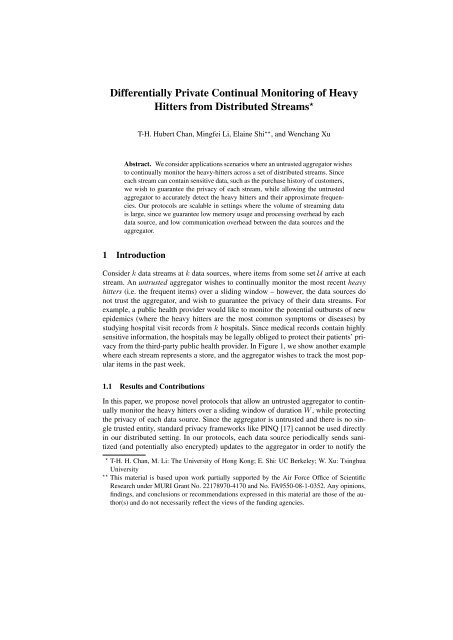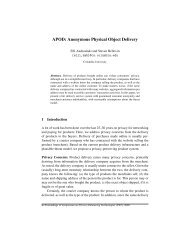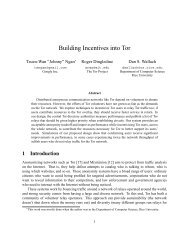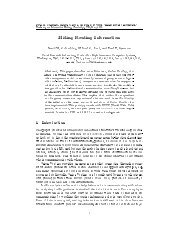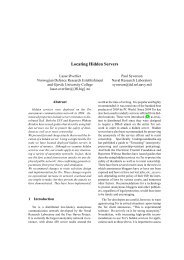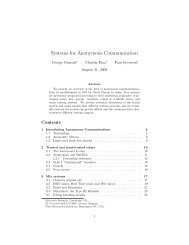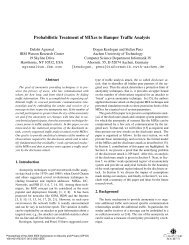Differentially Private Continual Monitoring of Heavy Hitters from ...
Differentially Private Continual Monitoring of Heavy Hitters from ...
Differentially Private Continual Monitoring of Heavy Hitters from ...
You also want an ePaper? Increase the reach of your titles
YUMPU automatically turns print PDFs into web optimized ePapers that Google loves.
<strong>Differentially</strong> <strong>Private</strong> <strong>Continual</strong> <strong>Monitoring</strong> <strong>of</strong> <strong>Heavy</strong><strong>Hitters</strong> <strong>from</strong> Distributed Streams ⋆T-H. Hubert Chan, Mingfei Li, Elaine Shi ⋆⋆ , and Wenchang XuAbstract. We consider applications scenarios where an untrusted aggregator wishesto continually monitor the heavy-hitters across a set <strong>of</strong> distributed streams. Sinceeach stream can contain sensitive data, such as the purchase history <strong>of</strong> customers,we wish to guarantee the privacy <strong>of</strong> each stream, while allowing the untrustedaggregator to accurately detect the heavy hitters and their approximate frequencies.Our protocols are scalable in settings where the volume <strong>of</strong> streaming datais large, since we guarantee low memory usage and processing overhead by eachdata source, and low communication overhead between the data sources and theaggregator.1 IntroductionConsider k data streams at k data sources, where items <strong>from</strong> some set U arrive at eachstream. An untrusted aggregator wishes to continually monitor the most recent heavyhitters (i.e. the frequent items) over a sliding window – however, the data sources donot trust the aggregator, and wish to guarantee the privacy <strong>of</strong> their data streams. Forexample, a public health provider would like to monitor the potential outbursts <strong>of</strong> newepidemics (where the heavy hitters are the most common symptoms or diseases) bystudying hospital visit records <strong>from</strong> k hospitals. Since medical records contain highlysensitive information, the hospitals may be legally obliged to protect their patients’ privacy<strong>from</strong> the third-party public health provider. In Figure 1, we show another examplewhere each stream represents a store, and the aggregator wishes to track the most popularitems in the past week.1.1 Results and ContributionsIn this paper, we propose novel protocols that allow an untrusted aggregator to continuallymonitor the heavy hitters over a sliding window <strong>of</strong> duration W , while protectingthe privacy <strong>of</strong> each data source. Since the aggregator is untrusted and there is no singletrusted entity, standard privacy frameworks like PINQ [17] cannot be used directlyin our distributed setting. In our protocols, each data source periodically sends sanitized(and potentially also encrypted) updates to the aggregator in order to notify the⋆ T-H. H. Chan, M. Li: The University <strong>of</strong> Hong Kong; E. Shi: UC Berkeley; W. Xu: TsinghuaUniversity⋆⋆ This material is based upon work partially supported by the Air Force Office <strong>of</strong> ScientificResearch under MURI Grant No. 22178970-4170 and No. FA9550-08-1-0352. Any opinions,findings, and conclusions or recommendations expressed in this material are those <strong>of</strong> the author(s)and do not necessarily reflect the views <strong>of</strong> the funding agencies.
Stream 1Store 1Stream 2Sanitized UpdatesStore 2This week’spopular items:…… …UntrustedAggregatorStream kStore kFig. 1. Problem setup. In this example, k stores wishes to continually monitor the popular itemsover the past week. The aggregator is assumed to be untrusted; and the stores may be concernedabout protecting their secret business information such as sales revenue, and protecting the privacy<strong>of</strong> their customers.aggregator <strong>of</strong> latest trends as observed by the data source. The aggregator is then ableto reconstruct the most recent popular items and their respective frequencies throughthese sanitized updates.We conduct experiments using the Netflix Contest Dataset, and demonstrate thatour algorithms can achieve low communication bandwidth and good utility in realisticapplication scenarios. We next explain the privacy guarantees and desirable featuresthat our constructions achieve.Two Levels <strong>of</strong> Privacy Protection. We propose protocols that achieve the following twodifferent aspects <strong>of</strong> privacy.Event-level differential privacy. Our first construction, referred to as the PDCH-LU algorithm(which stands for <strong>Private</strong> Distributed <strong>Continual</strong> <strong>Heavy</strong>-hitter - Lazy Update),achieves event-level differential privacy. Roughly speaking, the sanitized updates releasedshould be insensitive to the occurrence or non-occurrence <strong>of</strong> a single event.Intuitively, event-level differential privacy allows a store to guard the privacy <strong>of</strong> itscustomers, by concealing whether a certain purchase has taken place.In our constructions, we achieve event-level differential privacy through the addition<strong>of</strong> appropriate noises before the release <strong>of</strong> any statistics. Note also that ɛ event-leveldifferential privacy immediately implies mɛ user-level differential privacy, where m isthe maximum number <strong>of</strong> items for each user.Aggregator obliviousness. Through the use <strong>of</strong> bloom filters and special encryptionschemes, our second protocol, referred to as PDCH-BF (which stands for <strong>Private</strong> Distributed<strong>Continual</strong> <strong>Heavy</strong>-hitter - Bloom Filter), achieves even stronger privacy guarantees:specifically, it achieves aggregator obliviousness in addition to event-level differentialprivacy.On a high level, aggregator obliviousness advocates the need-to-know principle, i.e.,the aggregator should ideally learn the least amount <strong>of</strong> information necessary to performthe heavy-hitter monitoring task. Specifically, in our second construction PDCH-BF,
apart <strong>from</strong> the approximate frequencies <strong>of</strong> a subset <strong>of</strong> the relatively more popular itemsacross all streams, the aggregator learns nothing else.To achieve aggregator obliviousness, our second protocol PDCH-BF employs bloomfilters, as well as special encryption schemes [15, 20, 21] which support secure aggregationand controlled decryption <strong>of</strong> selective statistics.Notice that aggregator obliviousness immediately implies the following: 1) in theexample in Figure 1 the aggregator can learn the approximate frequencies <strong>of</strong> (a subset<strong>of</strong>) the items, but it cannot learn the transaction volume <strong>of</strong> each individual store whichmay be considered secret business information; and 2) although the aggregator canlearn which the heavy hitters are and their approximate frequencies across all streams,the aggregator fails to learn which streams are contributing to these heavy-hitters, andhow much each stream is contributing to these heavy hitters.A more detailed discussion <strong>of</strong> our privacy notions and their nuances can be foundin Section 2.3.Low Computational and Communication Overhead. Our protocols require only a smallamount <strong>of</strong> computation and memory <strong>from</strong> each data source. To process an item <strong>from</strong>the stream, a data source needs to update only a small number <strong>of</strong> counters; and in eachtime step, it needs to sample only a small number <strong>of</strong> random variables. This is desirablein numerous application settings – for example, in sensor network applications, whereeach node has low computational resources; or network intrusion detection scenarios,where routers cannot afford expensive real-time computation due to the large bandwidththroughput.Our protocols also requires low communication costs between the data sources andthe aggregator. Moreover, all communications are uni-directional <strong>from</strong> the data sourcesto the aggregator, and the data sources need not have interactions among themselves. Incontrast, generic secure multi-party computation construction [13] requires expensiveinteractive communication between the data sources.1.2 Related WorkOur work builds on several well-known lines <strong>of</strong> research. We describe some <strong>of</strong> theworks that are the most related to ours and refer the readers to the cited references formore extensive review on the relevant research areas.Differential Privacy in <strong>Continual</strong> Setting. Ever since Dwork [7] has introduced differentialprivacy, this notion has gained popularity in both the theory and security communities(see [8] for a quick review <strong>of</strong> the latest development). The idea <strong>of</strong> introducingrandomness to perturb the outputs <strong>of</strong> algorithms allows a clean and formal way toanalyze the trade<strong>of</strong>f between preserving input privacy and achieving output accuracy.Recently, privacy has been studied in the continual setting [5, 9, 10]. Specifically, achange in the input in the current time step would not only affect the output in the currenttime step, but also might have a long lasting effect in the future. Useful continualdifferentially private algorithms would need to mask this long term effect without sacrificingtoo much on accuracy. Chan et al. [5] gave a differentially private mechanismto continually report the number <strong>of</strong> 1’s seen so far in a bit stream with additive errorthat is polylogarithmic in the number <strong>of</strong> time steps. In the streaming model, Dwork et
al. [10] also distinguish between event-level privacy and user-level privacy: event-levelprivacy hides the occurrence <strong>of</strong> a particular event, while user-level privacy preventsadversaries <strong>from</strong> determining whether the stream contains any <strong>of</strong> a particular user’s activitiesat all. In this paper, we use event-level differential privacy as our privacy notion.Mir et al. [18] also considered the problem <strong>of</strong> private streaming algorithms to returnthe counts <strong>of</strong> heavy hitters, not the heavy hitters themselves. However, they consider amore general setting in which in each update, the counter <strong>of</strong> an item can be increasedor decreased arbitrarily, as long as the counter remains non-negative. Moreover, theirnotion <strong>of</strong> privacy hides the following change in the stream: any subset <strong>of</strong> occurrences<strong>of</strong> an item can be replaced with another item, and remaining updates can be arbitrarilyreordered; on the other hand, the total count <strong>of</strong> all items is public knowledge in theirsetting.Untrusted Aggregator. There have been works on studying the case when the aggregatoris untrusted [15, 20, 21], where cryptographic techniques are employed. We firstconsider protocols in which each node will desensitize its data first so that cryptographywill not be necessary; in order to achieve a stronger notion <strong>of</strong> privacy and security, weaugment our protocols by employing cryptographic techniques.Streaming Algorithms for <strong>Heavy</strong> <strong>Hitters</strong>. The first algorithm to output frequent itemswas given by Misra and Gries [19] (MG algorithm). They designed a deterministicalgorithm that reads a stream <strong>of</strong> W items and at the end gives the count <strong>of</strong> every item inthe stream with relative error λ (i.e., additive error at most λW ); the algorithm only usesO( 1 λ) words <strong>of</strong> memory. The MG algorithm was rediscovered several times [6, 14].Using the MG algorithm concurrently on overlapping blocks <strong>of</strong> different sizes,Arasu and Manku [1] gave a deterministic algorithm that continually estimate the count<strong>of</strong> every item with relative error λ with respect to the current window; the query andthe update time is O( 1 λ log 1 λ ), while O( 1 λ log2 1 λ) words <strong>of</strong> memory is required. Theyalso gave a randomized version, where both the time and the memory is O( 1 λ log 1δλ ),where δ is the failure probability.Lee and Ting [16] augmented the counters in the MG algorithm to include approximatepositions <strong>of</strong> where items occur, and consequently they improved Arasu andManku’s algorithm performance to O( 1 λ), for both running time and memory requirement.Distributed Streaming Protocols with Low Communication Cost. In the distributedstreaming model, each <strong>of</strong> k nodes receives its own stream, and the nodes communicatewith the aggregator, who wishes to estimate the number <strong>of</strong> times each item appears in allthe streams in the current window with relative error λ. Yi and Zhang [22] consideredthe special case with infinite window size and gave a 2-way communication (betweennodes and aggregator) protocol with total communication cost <strong>of</strong> O( k λlog N) words,where N is the total number <strong>of</strong> items arriving at all streams. Chan et al. [3] consideredthe case <strong>of</strong> a sliding window, and gave a one-way communication (<strong>from</strong> nodes to aggregator)protocol. Under the special case <strong>of</strong> exactly one item arriving in each time stepfor each stream, the communication cost for their protocol in L consecutive time stepsis O( k λ · ⌈ LW⌉log W ) words.Related Notion <strong>of</strong> Privacy. In Gantal et al. [11], it is mentioned that Dwork and Mc-Sherry proposed semantic privacy which measures how the posterior distribution on
the database changes after the transcript is observed. In particular, it is shown that ɛ-differential privacy implies (e ɛ − 1)-semantic privacy.2 Preliminaries2.1 Notations and ConventionsGiven a positive integer m, we let [m] := {1, 2, . . . , m}, and use N := {1, 2, 3, . . .}to index time steps. Let U be a set <strong>of</strong> n items. We use the standard notation Õ(·) tosuppress poly-logarithmic factors.We assume that an integer can be represented by O(1) words. Although later onwe use random distribution on unbounded integers, we show that with high probabilitythe magnitudes <strong>of</strong> the sampled integers are small. Hence, we can use modulo arithmeticover some large enough integer. We do not explicit explain how each data source obtainsits source <strong>of</strong> randomness, but we assume that it takes O(1) operations to sample arandom variable that is independent <strong>of</strong> the input data stream.2.2 Problem SetupWe assume a set <strong>of</strong> k ∈ N streams, originating at k data sources (also referred to asnodes) respectively. We assume that each data source only has limited memory andcomputational power. Each stream σ (i) ∈ U N where i ∈ [k] is a sequence <strong>of</strong> items <strong>from</strong>U, where σ (i) (t) ∈ U is the item appearing at time step t in the i-th stream.We consider an untrusted aggregator who wishes to continually monitor the heavyhitters over a sliding window <strong>of</strong> size W ∈ Z. Formally, the window at time step t overstream σ is the multiset W t (σ) := σ([t − W + 1, t]) containing all items coming tostream σ between time t − W + 1 and t. Given k streams {σ (i) : i ∈ [k]}, we writeW (i)t := W t (σ (i) ) and denote W [k]t := ⊎ i∈[k] W t (σ (i) ) as the multiset containing allitems <strong>from</strong> the k streams in the window at time t.The notion <strong>of</strong> heavy hitters is formally defined as below. Given a multiset W, weuse |W| to denote the number <strong>of</strong> items it contains and for x ∈ U, count x (W) is thenumber <strong>of</strong> times item x appears in W. Given 0 < θ < 1, we say an item x ∈ U is aθ-heavy hitter in the multiset W if count x (W) ≥ θ · |W|.Definition 1 (Approximate <strong>Heavy</strong> <strong>Hitters</strong>). Given 0 < λ, θ < 1 and a multiset W, aset S ⊆ U is a λ-approximation for θ-heavy hitters in W if1. the set S contains all θ-heavy hitters in W; and2. if x ∈ S, then x is a (θ − λ)-heavy hitter in W.Definition 2 (λ-approximate Count). Given a multi-set W on items in U, and an itemx ∈ U, an estimate ĉ(x) is called a λ-approximate count for x with respect to W, if|ĉ(x) − count x (W)| ≤ λ|W|.Observe that if we have a λ-approximate count for every item x ∈ U with respectto W, then we can compute a 2λ-approximation for heavy hitters in W.
Communication Protocol. Consider a node receiving some stream σ. At every timestep t, upon receiving the item σ(t), the node might send messages to the aggregator toupdate some counters. In the protocols that we consider, each message contains items<strong>of</strong> the form c ∈ Z or 〈x, c〉 ∈ U × Z, each <strong>of</strong> which we assume can be expressed inO(1) words. Given a (randomized) protocol Π, we denote by Π(σ) the (randomized)transcript which consists <strong>of</strong> the messages sent at every time step by the node that appliesthe protocol on the stream σ. We wish to reduce the amount <strong>of</strong> communication, say theaverage number <strong>of</strong> words sent per time step.Remark 1. In order to show that each item count has small relative error, we need alower bound on the total number items in the finite stream to absorb the noise error.Moreover, the way in which we use PMG in combination with Arasu and Manku’salgorithm [1] for fix-sized windows requires the assumption that exactly one item comesin the stream at every time step.2.3 Defining PrivacyAs mentioned earlier, we define our privacy notions based on the following principles:1) We advocate a need-to-know principle, the aggregator should ideally learn the leastamount <strong>of</strong> information necessary to perform the heavy hitter monitoring task. 2) Whilethe amount <strong>of</strong> information revealed to the aggregator is kept at a minimum, the informationeventually revealed to the aggregator should satisfy event-level differentialprivacy. In other words, any statistics revealed should be insentive to the occurrence ornon-occurrence <strong>of</strong> a single event. Intuitively, this helps to conceal whether some event<strong>of</strong> interest has happened, e.g., whether a customer Alice has purchased a specific item.Below, we formally define differential privacy and aggregator obliviousness.Differential Privacy. In our setting, each node regards the contents on its stream asprivate data. In particular, <strong>from</strong> the transcript <strong>of</strong> a node, the aggregator should not beable to distinguish between input streams that are close to each other. Formally, twodifferent streams σ 1 , σ 2 ∈ U N are adjacent or neighbors (denoted as σ 1 ∼ σ 2 ) if theydiffer at exactly one time step. We use the notion <strong>of</strong> event-level differential privacy forprotocols.Definition 3 (Differential Privacy for Protocols). Given ɛ > 0, a (randomized) protocolΠ is ɛ-differentially private if for any adjacent streams σ 1 and σ 2 , any subset O<strong>of</strong> possible output transcripts, Pr[Π(σ 1 ) ∈ O] ≤ exp(ɛ) · Pr[Π(σ 2 ) ∈ O], where therandomness comes <strong>from</strong> the protocol.Aggregator Obliviousness. As we shall see, as an intermediate step in our protocols,each node has some private number and the goal is for the aggregator to learn the sum <strong>of</strong>all the nodes’ numbers, but nothing more. Formally, each node has some data in D andwe use x ∈ D n to denote a configuration <strong>of</strong> all the nodes’ data. Intuitively, a protocolΠ is aggregator oblivious with respect to some function f : D n → O if for all x andy such that f(x) = f(y), no polynomial-time adversary can distinguish between thetranscripts Π(x) and Π(x) with non-negligible probability.
Definition 4 (Aggregator Obliviousness). Let κ ∈ N be a security parameter. A protocolensemble {Π κ } κ∈N is aggregator obliviousness with respect to the function f :D n → O if there exists a negligible function η : N → R + such that for all x and y suchthat f(x) = f(y), for all decisional probabilistic polynomial-time Turing machines A,| Pr[A(Π κ (x)) = 1] − Pr[A(Π κ (y)) = 1]| ≤ η(κ),where the probability is over the randomness <strong>of</strong> the protocol Π κ and the Turing machineA.2.4 Defining UtilityRecall that for each i ∈ [k], each node i receives some stream σ (i) and follows some(randomized) protocol to send messages to the aggregator in every time step. Basedon the messages received up to time t, the aggregator computes for each x ∈ U somenumber A(t, x), which is an estimate for count x (W [k]t ). Observe that A(t, x) is a randomvariable, whose randomness comes <strong>from</strong> the randomized protocols. We use thefollowing notion to measure the usefulness <strong>of</strong> A(t, ·) with respect to W [k]t for each t.Definition 5 ((ξ, δ)-Usefulness). Suppose W is a multiset containing items in U, andA ∈ R U is a collection <strong>of</strong> random variables indexed by U. Then, A is (ξ, δ)-useful withrespect to W, if with probability at least 1 − δ, for every item x ∈ U,|A(x) − count x (W)| ≤ ξ; in particular, if ξ = λ|W|, then A(x) is a λ-approximatecount for x with respect to W.Definition 6 ((ξ, δ)-Simultaneous Usefulness.). Let T be an index set. Suppose forany t ∈ T , W t is a multiset containing items in U, and A t is a collection <strong>of</strong> randomvariables indexed by U. Then, {A t } t∈T is (simultaneously) (ξ, δ)-useful with respectto {W t } t∈T , if with probability at least 1 − δ, for every t ∈ T and every item x ∈ U,|A t (x) − count x (W t )| ≤ ξ.3 Achieving Differential Privacy3.1 RoadmapThis section describes a protocol between the data sources and an aggregator, allowingthe aggregator to continually monitor the heavy hitters over a sliding window. We willshow how to achieve event-level differential privacy in this section. Later in Section 4,we show how to achieve aggregator obliviousness.We proceed with the following three-step recipe:1. The PMG algorithm outputs the heavy hitters in a single stream. In Section 3.2,we describe a private streaming algorithm, which allows a single data source tooutput the approximate heavy hitters in a stream, after a one-pass scan <strong>of</strong> the entirestream. Since this algorithm builds on top <strong>of</strong> the Misra-Gries streaming algorithm[19], we refer to it as the <strong>Private</strong> Misra-Gries (PMG) algorithm. The MGAlgorithm maintains an approximate vector <strong>of</strong> item counts by storing only non-zerocounts explicitly for only a small number <strong>of</strong> items. The main technical challengeto privatize the MG Algorithm is to show that this approximate vector has smallsensitivity.
2. The PCC algorithm continually monitors the recent heavy hitters in a singlestream. In Section 3.3, we extend the aforementioned PMG algorithm to derivea <strong>Private</strong> <strong>Continual</strong> <strong>Heavy</strong>-hitter (PCC) algorithm, which supports the continualmonitoring <strong>of</strong> heavy hitters over a sliding window in a single stream. The maintechnique in this step is the use <strong>of</strong> a binary interval tree which allows us to achievesmall memory when the window size is large.3. The PDCH-LU protocol continually monitors the recent heavy hitters acrossmultiple streams. Finally, in Section 3.4, we extend the above PCC algorithm,which works for a single stream, to the distributed setting. In the resulting protocolPDCH-LU (<strong>Private</strong> Distributed <strong>Continual</strong> <strong>Heavy</strong>-hitter - Lazy Update), in order tosave communication cost, each data source sends sanitized updates to the aggregatorwhenever necessary (hence lazy updates), to inform the aggregator <strong>of</strong> latesttrends in its observed stream. The aggregator can in turn continually output theapproximate heavy hitters across all streams over a sliding window.3.2 <strong>Private</strong> Misra-Gries AlgorithmIn this section, we consider a sub-problem, which will be a useful building block toconstruct the private streaming protocol at a node. Given a stream <strong>of</strong> length T and anerror parameter 0 < λ < 1, the goal is to estimate the number <strong>of</strong> times each item in Uappears in the stream with additive error λT .Our approach is based on the (non-private) MG Algorithm [19], which keeps explicitcounters for only O( 1 λ) items. Observe that since we accept λT additive error, ifan item x ∈ U appears for less than λT times in the stream, then we do not need tokeep a counter explicitly for x ∈ U and can give an estimate count <strong>of</strong> zero. Because atmost O( 1 λ) items can appear for at least λT times in a stream <strong>of</strong> length T , intuitively itis sufficient to keep O( 1 λ) explicit counters. The MG Algorithm makes sure that at anypoint in time at most O( 1 λ) items have explicit non-zero counts. If an item arrives andwe need to create an extra counter, all existing non-zero counters are decremented by1; this step keeps the number <strong>of</strong> non-zero counters small. On the other hand, whenevera non-zero counter <strong>of</strong> some item x decreases by 1, there are Θ( 1 λ) other items that alsohave their counts decreased by 1. Since this can happen for at most λT times, the finalcount for each item has additive error at most λT .At the end <strong>of</strong> the MG Algorithm, the output corresponds to a count vector f ∈ Z U ,which has at most O( 1 λ) non-zero coordinates. Lemma 2 states that this vector hassensitivity at most O( 1 λ), and hence we can apply the techniques <strong>of</strong> geometric noise toachieve differential privacy. The properties <strong>of</strong> the private version <strong>of</strong> the MG Algorithmare given in the following lemma, whose pro<strong>of</strong> is given in the full version [4].Lemma 1 (<strong>Private</strong> MG Algorithm). Given a privacy parameter ɛ > 0 and an approximationparameter 0 < λ < 1, there is a (randomized) mechanism M, denotedas PMG(ɛ, λ) (<strong>Private</strong> Misra-Gries), that takes any finite stream σ and after one passoutputs a vector ̂f ∈ Z U such that the following properties hold.1. ɛ-Differential Privacy: for any adjacent streams σ 1 and σ 2 , any subset O ⊆ Z U ,Pr[M(σ 1 ) ∈ O] ≤ exp(ɛ) · Pr[M(σ 2 ) ∈ O], where the probability is over therandomness <strong>from</strong> the mechanism.
2. Utility: Suppose 0 < δ < 1, and the length T <strong>of</strong> the stream σ satisfies T ≥32λ 2 ɛ log n δ . Then, the vector ̂f is (λT, δ)-useful with respect to the multiset σ([T ])<strong>of</strong> items in the stream.3. The mechanism uses only O( 1 λ ) words <strong>of</strong> memory. In particular, at most O( 1 λ )coordinates <strong>of</strong> ̂f are non-zero. Moreover, it takes O( 1 λ) operations to process eachitem, and samples O( 1 λ) random variables in total.We modify the Misra-Gries Algorithm [16, 19] to get a counting mechanism, whichwe call the <strong>Private</strong> Misra-Gries Algorithm (PMG) and is given in Algorithm 1. Weoutline the main ideas <strong>of</strong> the algorithm. In the literature, it is common to achieve differentialprivacy by adding geometric noise. However, since we want to be careful aboutmemory usage, we want the output <strong>of</strong> the mechanisms to be integral. Therefore, we addnoises sampled <strong>from</strong> symmetric geometric distributions [12].Definition 7 (Geometric Distribution). Let α > 1. We denote by Geom(α) the symmetricgeometric distribution that takes integer values such that the probability massfunction at l is α−1α+1 · α−|l| .The following property <strong>of</strong> symmetric geometric distribution is useful for designingdifferentially private counting mechanisms.Fact 1 Let u, v ∈ Z n be two vectors such that ||u − v|| 1 ≤ ∆, where ||u − v|| 1 =∑ ni=1 |u i − v i | is the l 1 -norm <strong>of</strong> u − v. Let r ∈ Z n be a random vector whose coordinatesare independent random variables sampled <strong>from</strong> symmetric geometry distributionGeom(exp( ɛ ∆ )). Then, for any vector p ∈ Zn , Pr[u + r = p] ≤ exp(ɛ) · Pr[v + r = p].Definition 8 (Sensitivity). Let f : U T → Z n be a function that takes a stream <strong>of</strong> lengthT as input. The sensitivity <strong>of</strong> f, denoted by ∆(f), is max σ1∼σ 2||f(σ 1 ) − f(σ 2 )|| 1 .By Fact 1, for any function f : U T → Z n such that ∆(f) ≤ ∆, we can makeits output ɛ-differentially private by adding independent random noise sampled <strong>from</strong>Geom(exp( ɛ ∆)) to coordinates <strong>of</strong> f. The following lemma explains what parameter oneshould use for the geometric distribution in the PMG Algorithm to achieve differentialprivacy. We give its pro<strong>of</strong> in the full version [4].Lemma 2. In Algorithm 1 after Line 10, the function f : U T → Z U has sensitivity atmost β + 1, where β := ⌈ 2 λ ⌉.3.3 <strong>Private</strong> <strong>Continual</strong> <strong>Heavy</strong>-Hitter <strong>Monitoring</strong> over a Sliding WindowIn this section, we use PMG to construct a differentially private mechanism named<strong>Private</strong> <strong>Continual</strong> <strong>Heavy</strong>-hitter (PCC), that uses small memory and maintains someefficient data structure at every time step.As intuitively illustrated as in Figure 2, we build a binary interval tree, where eachleaf node represents ⌈ ⌉λW4 (= 1 in the figure) time steps, and each non-leaf node representsa range <strong>of</strong> time steps. (Note that Figure 2 only depicts the bottom few levels <strong>of</strong>this binary interval tree due to reasons stated below). We refer to each node as a block,
Input: A privacy parameter ɛ, an approximation parameter λ, and a finite stream σ ∈ U T<strong>of</strong> length T .Output: A vector ̂f ∈ Z U , where ̂f(x) is a λ-approximate count <strong>of</strong> x with respect toσ([T ]) with high probability.1 For each x ∈ U, f(x) and ̂f(x) are (implicitly) initialized to 0;2 β ← ⌈ 2 λ ⌉;3 for t ← 1 to T do4 f(σ(t)) ← f(σ(t)) + 1;5 if the number <strong>of</strong> items x such that f(x) > 0 exceeds the threshold β then// the decreasing step6 for x ∈ U such that f(x) > 0 do7 f(x) ← f(x) − 1;8 end9 end10 end// The sensitivity ∆(f) ≤ β + 111 for each x ∈ U do// In the full version, we give a faster procedure thatsamples only O(β) random variables and achieves thesame output distribution.12 Sample a fresh independent noise r x ∼ Geom(exp( ɛβ+1 ));13 ̂f(x) ← max{f(x) + rx, 0};// we only keep the top β non-zero ̂f(x)’s14 if there are more than β items x with ̂f(x) ≠ 0 then15 Let y be the item with smallest non-zero ̂f(y) (resolving ties arbitrarily);16 Set ̂f(y) ← 0;17 end18 end19 Output ̂f;Algorithm 1: <strong>Private</strong> Misra-Gries Algorithm PMG(ɛ, λ)and run the subroutine PMG algorithm for each block, with appropriate privacy andapproximation parameters. To output the heavy hitters for any time range, it suffices to“sum up” a logarithmic number <strong>of</strong> blocks in the binary interval tree – since any rangecan be represented by the union <strong>of</strong> a logarithmic number <strong>of</strong> disjoint blocks. In Figure 2,since we consider a window size <strong>of</strong> W = 7, we only need the bottom 3 levels <strong>of</strong> thebinary tree. The main purpose <strong>of</strong> the binary interval tree technique is to save memoryand allow faster computation.Small memory. The amount <strong>of</strong> memory necessary is Õ( 1 λ) independent <strong>of</strong> W . Toachieve this, we use a garbage collection technique, where a data source saves onlythe blocks which will later be needed, and discard all “expired” blocks which will nolonger be needed. As shown in Figure 2, at any point <strong>of</strong> time, a block can be one <strong>of</strong> thefollowing four types: 1) expired, i.e., will no longer be needed in the future; 2) active,i.e., the block has completed construction, and will be needed now or in the future; 3)
Fig. 2. <strong>Continual</strong> counting over a sliding window <strong>of</strong> the past week.under-construction, i.e., the heavy hitters for this block are currently being constructed;or 4) future, i.e., construction for this block will start at some point in the future. Specifically,in the PCC algorithm, a data source saves only the blocks that are either activeor under construction – and the number <strong>of</strong> such nodes is O( 1 λ) at any point in time. Observethat the number <strong>of</strong> counters kept for binary nodes at different levels are different,and we later give a calculation to show that the total number <strong>of</strong> counters kept at anytime is O( 1 λ log2 1 λ ).Faster Computation. Observe that we could achieve even smaller memory if we onlystore the leaf nodes <strong>of</strong> the binary construction. However, in order to produce an estimatecount over a window, we would need to look at Ω( 1 λ) leaf nodes. Using the binaryconstruction, we only need to look at O(log 1 λ) binary tree nodes for count estimationat each step.Low Communication Bandwidth. Notice we could achieve even smaller memory ifonly one leaf node (corresponding to W 0 = ⌈ ⌉λW4 time steps) in the binary tree constructionis stored at any time; however, updates need to be sent to the aggregator everyW 0 time steps. As we shall see in Section 3.4, if information about each stream in thecurrent window is kept at each node, then the communication bandwidth to the aggregatorcan be greatly reduced.Note that a similar binary tree technique was also used in [1, 5].We now give a formal description <strong>of</strong> the PCC algorithm, as well as its theoreticguarantees. At every time step t, PCC maintains a dictionary P t , which is a collection<strong>of</strong> at most O( 1 λ log 1 λ ) pairs (x, c x) ∈ U ×Z where for every item x ∈ U, item x appearsin at most one pair in P t . Hence, P t can also be interpreted as a vector Z U or a function<strong>from</strong> U to Z in the natural way: P t (x) := c x if (x, c x ) ∈ P t , and P t (x) := 0 otherwise.Observe that only non-zero counts need to be stored in the dictionary , and we denoteby |P t | the number <strong>of</strong> items x having non-zero counts P t (x). The following lemma isthe main result <strong>of</strong> the section.Lemma 3 (<strong>Private</strong> <strong>Continual</strong> <strong>Heavy</strong> Hitter <strong>Monitoring</strong>). Given a privacy parameterɛ > 0, and an approximation parameter 0 < λ < 1, there exists a continual countingmechanism M, denoted as PCC(ɛ, λ) (<strong>Private</strong> <strong>Continual</strong> <strong>Heavy</strong>-hitter), that takes an
infinite data stream σ ∈ U N , and maintains at every time step t a dictionary P t ∈ Z U .We write M(σ) := (P t ) t∈N ∈ Z N×U . The following properties hold.1. ɛ-Differential Privacy: for any adjacent streams σ 1 and σ 2 , any subset O ⊆ Z N×U ,Pr[M(σ 1 ) ∈ O] ≤ exp(ɛ) · Pr[M(σ 2 ) ∈ O], where the probability is over therandomness <strong>from</strong> the mechanism.2. Utility: Suppose 0 < δ < 1 and L > 0. If W ≥ Θ( 1λ 2 ɛ (log2 1 λ ) · log( n δ log 1 λ )).Then, at every time step t ∈ N, P t is (λW, δ)-useful with respect to W t . If W ≥Θ( 1λ 2 ɛ (log2 1 L+Wλ) · log(λW · nδ )), then for any T ≥ L + 1, {P t} t∈[T −L,T ] is simultaneously(λW, δ)-useful with respect to {W t } t∈[T −L,T ] .3. The mechanism uses only O( 1 λ log2 1 λ ) words <strong>of</strong> memory. Moreover, it takes O( 1 λ log 1 λ )operations to process each item in the stream, and samples at most O( 1 λ log 1 λ ) randomvariables in each time step.4. For every time step t, |P t | = O( 1 λ log 1 λ ).Scheme Description PCC(ɛ, λ). We assume 1 λ is a power <strong>of</strong> 2; otherwise, let λ′ :=max{ 1 1: < λ} and run PCC(ɛ, λ ′ ).2 k 2 kLet W 0 := ⌈ ⌉λW4 > 0, and let l := log4λ . Note that we have W 2≤ W 0·2 l ≤ W . Wedivide the time steps into binary hierarchical blocks with l + 1 levels, where all blocksat the same level have the same size, are disjoint and cover all time steps. In particular,for 0 ≤ i ≤ l and j ≥ 1, the jth block at level i is the interval [(j − 1)W i + 1, jW i ] <strong>of</strong>W i := 2 i · W 0 time steps; we use block Bj i to denote the multiset <strong>of</strong> items <strong>from</strong> streamσ contained in this interval, i.e., Bj i = σ([(j − 1)W i + 1, jW i ]). At any time t, eachblock Bj i is in one <strong>of</strong> the following four states.1. future: None <strong>of</strong> Bj i’s items has come into W t(σ), i.e., (j − 1)W i + 1 > t;2. under-construction: Some <strong>of</strong> Bj i’s items are in W t(σ), and the remaining itemshave not come into W t , i.e., (j − 1)W i + 1 ≤ t and jW i > t;3. active: Bj i is totally within W t(σ), i.e., t − W + 1 ≤ (j − 1)W i + 1 ≤ jW i ≤ t;4. expired: At least one <strong>of</strong> Bj i’s items has expired, i.e., (j − 1)W i + 1 < t − W + 1.For each block Bj i , right before the time step when its state becomes under-construction,i.e., t = (j − 1)W i + 1, PCC(ɛ, λ) initiates an instance <strong>of</strong> PMG(ɛ i , λ i ) on Bj i, whereɛ1ɛ i := and λ2 l−i+1 i :=2 i (l+1) . When Bi j becomes active, PMG(ɛ i, λ i ) produces avector ̂f B ij∈ Z U , which has O( 1 λ i) non-zero coordinates. Then, PCC(ɛ, λ) uses O( 1 λ i)words <strong>of</strong> memory to maintain this vector until Bj i expires.Cover by Disjoint Active Blocks. Observe that at any time t, there exists a collectionC t <strong>of</strong> disjoint active blocks, such that C t contains at most two blocks <strong>from</strong> each level,and that the union <strong>of</strong> blocks in C t is the union <strong>of</strong> all active level-0 blocks. At anytime, PCC(ɛ, λ) maintains the dictionary P t , where P t = {(x, ∑ B∈ĈfB t(x)) : x ∈U and ∑ B∈ĈfB t(x) > 0}.We prove that PCC maintains differential privacy. The analysis <strong>of</strong> the remainingproperties is similar to that in [1, Section 5], and we include the pro<strong>of</strong>s in the fullversion [4].Privacy Guarantee. Observe that the output <strong>of</strong> PCC is a deterministic function <strong>of</strong>PMG’s outputs on all blocks. Hence, we need only to show ɛ-differential privacy ismaintained with respect to ( ̂f B ) ∀B . Consider an item arriving at time step t. We analyze
which <strong>of</strong> the blocks would be affected if σ(t) is replaced with a different item. It is nothard to see that the item σ(t) can be in at most one block at each level. Observe that ̂f Bfor a level-i block B maintains ɛ i -differential privacy, where ɛ i =ɛ and observe2 l−i+1that ∑ li=0 ɛ i ≤ ɛ. Hence, we conclude that PCC(ɛ, λ) preserves ɛ-differential privacy.3.4 <strong>Private</strong>ly and <strong>Continual</strong>ly <strong>Monitoring</strong> <strong>Heavy</strong> <strong>Hitters</strong> Across DistributedStreamsIn this section, we use PCC to design a protocol between k data sources and an aggregator,allowing the aggregator to continually monitor the global heavy hitters. Theresulting protocol, called PDCH-LU (which stands for <strong>Private</strong> Distributed <strong>Continual</strong><strong>Heavy</strong>-hitter - Lazy Update) has low communication cost; moreover, the messages sentby each data source is differentially private against the aggregator.Observe that each node could send the privatized updates to the aggregator at everytime step in order for the aggregator to compute the approximate heavy hitters. However,to save communication bandwidth, we use a lazy update approach: updates areonly required when the count <strong>of</strong> an item changes by a huge amount. Chan et al. [3]gave a distributed algorithm (called Approximate Counting (AC)) based on this ideaand proved that it achieves small error. Since the AC Algorithm in [3] only needs anapproximate count in the current window for each item in each stream at any time, ourPCC algorithm is sufficient for this purpose. We give the main result and the construction<strong>of</strong> the protocol; the detailed analysis is given in the full version [4].Theorem 1. Suppose ɛ > 0 is a privacy parameter, 0 < λ < 1 is an approximationparameter, W is the window size and L is some positive integer. Given k streams eachreceived by a node, every node can run an ɛ-differentially private communication protocolwith the same time and space performance as PCC(ɛ, λ 11) in Lemma 3 to sendmessages to the aggregator such that if W ≥ Θ( 1λ 2 ɛ (log2 1 L+Wλ) log(λW · kn δ)), then forevery time interval T = [T + 1, T + L] (where T ≥ W ), with probability at least 1 − δ,at every time t ∈ T , the aggregator can maintain a λ-approximate count for every itemwith respect to the current window in all streams, and the total communication cost byall nodes in the period T is O( k λ · ⌈ ⌉LW log W ) words.Algorithm for the Aggregator. The aggregator maintains a counter c i (x) (initially 0)for each stream i ∈ [k] and each item x ∈ U. Upon receiving a message 〈x, c〉 <strong>from</strong>node i, the aggregator updates the counter c i (x) := c. In each time step t, the aggregatorcalculates a count c(x) = ∑ i∈[k] c i(x); to produce a 2λ-approximate set <strong>of</strong> θ-heavyhitters, the aggregator releases the set <strong>of</strong> items x such that c(x) ≥ (θ − λ)kW .Protocol for Each Data Source. We use Algorithm AC (Approximate Counting) in[3, Section 2.2] to get a protocol (shown in Algorithm 2), denoted as PDCH-LU(ɛ, λ)(<strong>Private</strong> Distributed <strong>Heavy</strong>-hitter - Lazy Update). Each node i runs an instance <strong>of</strong>PDCH-LU(ɛ, λ) on the stream σ (i) it receives.4 Achieving Aggregator ObliviousnessThe main construction described earlier in Section 3 is a protocol for k nodes to communicatewith an aggregator, whose task is to keep track <strong>of</strong> heavy hitters over a sliding
Input: A privacy parameter ɛ, an approximation parameter λ, and a stream σ ∈ U NRun an instance <strong>of</strong> PCC(ɛ, λ ) and (implicitly) initialize Last(x) := 0 for each x ∈ U;11// We only store non zero Last(x)’s.for t ← 1 to ∞ d<strong>of</strong>or each x such that P t(x) > 0 or Last(x) > 0 doUp: if P t(x) > Last(x) + 9 · λW , send 〈x, Pt(x)〉 and set Last(x) ← Pt(x);11Off: if Last(x) > 0 and P t(x) < 3 · λW , send 〈x, 0〉 and set Last(x) ← 0;11Down: if P t(x) < Last(x) − 9 · λW , send 〈x, Pt(x)〉 and set11Last(x) ← P t(x);endendAlgorithm 2: PDCH-LU(ɛ, λ)window. This protocol guarantees differential privacy at the event level, i.e., the statisticsreleased to the aggregator is not affected by the change <strong>of</strong> one event.In this section, we describe a protocol which achieves a stronger level <strong>of</strong> privacyprotection, i.e., we additionally achieve aggregator obliviousness on top <strong>of</strong> event-leveldifferential privacy. Specifically, we wish to reveal the minimum amount <strong>of</strong> informationpossible to the aggregator, for it to successfully perform the heavy hitter monitoringtask.The main techniques we use to achieve aggregator obliviousness include Bloomfilters [2] as well as special encryption schemes [15, 20, 21] that support the controlleddecryption <strong>of</strong> selected statistics. Using these techniques to augment the PMG protocoldescribed earlier, we achieve aggregator obliviousness in the sense that the aggregatorlearns only the approximate counts <strong>of</strong> each item, but nothing else. In particular, theaggregator does not learn which data sources are contributing to the heavy hitters andhow much their contributions are.In our protocol to be described later in this section, each node communicates theupdate with the aggregator every W 0 = ⌈ ⌉λW4 time steps. We then employ Bloomfilters to effectively reduce the bandwidth overhead. Observe that without the Bloomfilters, we would need to perform n secure additions, one for each item, for each update.We shall see that using Bloom filters, we can reduce the dependence <strong>of</strong> the number <strong>of</strong>additions per update on n to O(log n).4.1 Background on Special Encryption SchemeAs a building block for achieving aggregator obliviousness, we employ a special encryptionscheme which supports the conditional decryption <strong>of</strong> selected statistics. Inparticular, we can use either the encryption scheme proposed by Shi et al. [21], Rastogiet al. [20], or Kursawe et al. [15] In comparison, the scheme by Shi et al. [21]requires uni-directional communication <strong>from</strong> the data sources to the aggregator, but thedecryption algorithm is more expensive; whereas the scheme by Rastogi et al. [20] requiresbi-directional communication between the data sources and the aggregator, buthas smaller decryption overhead. The scheme by Kursawe et al. [15] only needs unidirectionalcommunication and has low overhead, but each node needs to store Θ(k)
keys corresponding to all other nodes. We now give a high-level overview <strong>of</strong> these specialencryption schemes. The special encryption schemes we employ typically involvethe following algorithms or phases:Setup. In a one-time setup phase, cryptographic keying materials are distributed to alldata sources and the aggregator. In particular, each data source receives an encryptionkey, and the aggregator receives a cryptographic capability which will allow it to laterdecrypt the sum <strong>of</strong> all data sources in each aggregation time step. The setup phase caneither be performed by an <strong>of</strong>fline authority (which will no longer be needed after thesetup phase); or through an interactive multi-party protocol amongst the data sourcesand the aggregator.Periodic Encryption and Aggregation. In each time step, each data source i ∈ [k] encryptsa value x i using the encryption key established in the setup phase, and sendsthe ciphertext to the aggregator. After receiving ciphertexts <strong>from</strong> all data sources, theaggregator can use its cryptographic capability to decrypt the value ∑ ki=1 x i, but learnnothing else. In the construction by Shi et al. [21] and Kursawe et al. [15], this decryptionis done solely by the aggregator, whereas in the scheme by Rastogi et al. [20], theaggregator needs to communicate with the data sources to perform decryption.In the remainder <strong>of</strong> this section, we will use this special encryption scheme as ablackbox – for more algebraic details on how these schemes are constructed, we referthe readers to [15, 20, 21].4.2 Augmenting PMG Algorithm with Secure Bloom FiltersStraightforward Solution using Cryptography. We first describe a straightforwardconstruction using one <strong>of</strong> the special encryption schemes [15, 20, 21]. A brief backgroundon these encryption schemes was given in Section 4.1. We show that one drawback<strong>of</strong> this straightforward construction is its high bandwidth overhead. Later, we shallemploy Bloom filters to reduce the bandwidth consumption.The basic idea is to apply the special encryption scheme all items in the universe.Suppose each <strong>of</strong> the k nodes is running PMG(ɛ, λ) on its finite stream as describedin Section 3.2. Each node v ∈ [k] produces some ̂f v : U → Z, which is representedby at most β = O( 1 λ) non-zero counters. In every time step, for each x ∈ U, eachdata source encrypts its observed frequency ̂f v (x), and sends the ciphertext to the aggregator.The aggregator may then use its cryptographic capability to decrypt the totalfrequency ∑ ̂f v∈[k] v (x) for each x ∈ U – and meanwhile, the security <strong>of</strong> these encryptionschemes guarantee that the aggregator learns nothing else beyond the totalfrequency <strong>of</strong> each item.It is not hard to see that each node needs to send Ω(n) words (proportional to thesize <strong>of</strong> U) to the aggregator. Even though each node only has β non-zero counters, it stillhas to participate in every addition such that the aggregator does not know where thenon-zero values come <strong>from</strong>. We would like to decrease the communication cost throughthe use <strong>of</strong> Bloom filters.Construction with Bloom Filters. Let 0 < δ < 1 be the desired failure probability,i.e., with probability at least 1 − δ, the aggregator can retrieve ∑ ̂f v∈[k] v (x) for all
x ∈ U. Let P := ⌈ ⌉ln n δ and Q := ⌈ekβ⌉, where e is the natural number and β isthe maximum number <strong>of</strong> non-zero counters for each node. We assume there is a publicfamily {H p : U → [Q]} p∈[P ] <strong>of</strong> random hash functions that satisfy the followingproperties.1. The functions H p are totally independent over different p ∈ [P ].2. For each p ∈ [P ], H p is pairwise independent over U, i.e., for x ≠ y, H p (x) andH p (y) are independent; moreover, for each x ∈ U and each q ∈ [Q], Pr[H p (x) =q] = 1 Q .Bloom Filters for Each Node. Each node v constructs a table A v <strong>of</strong> size P × Q that isconstructed in the following way.1. Initially, every entry A v [p][q] := 0.2. For each x ∈ U such that ̂f v (x) ≠ 0 (note that there are at most β such x’s), foreach p ∈ [Q], increment A[p][H p (x)] by ̂f v (x).Secure Addition <strong>of</strong> Bloom Filters. Using one <strong>of</strong> the secure periodic schemes [15, 20,∑21] described above, the aggregator learns for each p ∈ [P ] and q ∈ [Q], A[p][q] :=v∈[k] A v[p][q]. Observe that each node sends O(P Q) = O( k λ log n δ) words to theaggregator.Retrieving Sum <strong>of</strong> Counts for Each Item. For an item x, the aggregator computesmin p∈[P ] A[p][H p (x)].Theorem 2. With probability at least 1 − δ, the aggregator retrieves ∑ v∈[k] ̂f v (x) accuratelyfor all x ∈ U.Pro<strong>of</strong>. Fix some x ∈ U. Observe that the aggregator makes a mistake for item x iff forall p ∈ [P ], there exists some y ≠ x such that H p (x) = H p (y) and there exists v ∈ [k]such that ̂f v (y) ≠ 0.Observe that each node v can only have at most β non-zero counts. For fixed p ∈P, by pairwise independence <strong>of</strong> H p over U and uniformity <strong>of</strong> H p (y) over [Q], theprobability that there exists some y ≠ x such that some node has non-zero count for yand H p (x) = H p (y) is at most kβ Q ≤ 1 e .By the total independence <strong>of</strong> H p over p’s, it follows that the probability that the1aggregator makes a mistake for item x is at most ≤ δ e P n. Using the union bound overall x ∈ U, it follows that the probability that the aggregator makes a mistake for someitem is at most δ, as required.4.3 Distributed Protocol Achieving Aggregator ObliviousnessWe next describe how the PMG Algorithm augmented with Bloom Filters can be used todesign a distributed protocol that achieves aggregator obliviousness – the resulting protocolis referred to as PDCH-BF (<strong>Private</strong> Distributed <strong>Continual</strong> <strong>Heavy</strong>-hitter - BloomFilter).Each node performs the binary construction as in the PCC algorithm described inSection 3.3. In particular, for a block at level i with size W i = 2 i · W 0 = 2 i · λW 4 ,PMG(ɛ i , λ i ) is run with ɛ i :=ɛ and λ2 l−i+1 i := 12 i (l+1). As soon as PMG is completedfor a block, a Bloom filter is constructed for that block as described in Section 4.2. TheBloom filter for that block is encrypted and sent to the aggregator.
For a particular block, after the aggregator has received the ciphertexts <strong>of</strong> the Bloomfilters <strong>from</strong> all the k nodes, it can decrypt the sum <strong>of</strong> the Bloom filters and reconstructthe counts for all items in that block.Observe that to estimate the counts in a window, the aggregator just needs the counts<strong>from</strong> at most 2 log 1 λblocks. Hence, in order to achieve failure probability <strong>of</strong> δ due tothe Bloom filters for each window, it suffices to set the Bloom filter failure probabilityfor each block to be . There is also failure probability δ due to the randomnessδ2 log 1 λintroduced to achieve differential privacy. Hence, Lemma 3 implies the aggregator cancompute λ-approximate heavy hitters within a window with probability 1 − 2δ.Communication Cost. For each node, the communication cost for a block at leveli is O( k λ ilog n δ 0) words, where λ i =12 i·(l+1) , l = log 4 λ and δ 0 =δ2(l+1) . Moreover,a block at level i is constructed every W i := 2 i · W 0 = 2 i · λW 4time steps.Hence, it follows that the average number <strong>of</strong> words <strong>of</strong> communication per time step isO( kλW log2 1 λ log n log 1 λδ).5 Experiments5.1 Experimental SetupThe data used in our experiment was constructed <strong>from</strong> the Netflix Contest Dataset,which contains n = 17770 movies with 480189 users’ ratings <strong>from</strong> 1999-11-11 to2005-12-31. We divided the users randomly into 100 groups to construct 100 streams.We selected roughly 200 days’ data <strong>of</strong> each stream <strong>from</strong> 2002-09-23 to 2003-04-30to conduct our experiments, where we continually monitored the moving average overa window size <strong>of</strong> 90 days. We plot the result for the last 10 days by when the systemshould have become stable. We use the following parameters in our experiments:heavy-hitter fraction θ = 0.004 and error λ = 0.001. In our experiments, we considerdifferential privacy parameter ɛ = 1, 2, 5, 10. Note that there is no consensus on whatprivacy parameters are acceptable in practice, and even for ɛ = 1, the scheme still <strong>of</strong>ferssome guarantee on privacy.For the Bloom filters, we choose the number <strong>of</strong> hash functions to be P = 8, andthe array size for each hash function to be Q = ⌈e · 3600⌉ (we explain the choice <strong>of</strong> Qbelow).Practical Optimization. Several aspects <strong>of</strong> our protocols can be further optimized inthis application.1. Empirical Sensitivity <strong>of</strong> PMG Count Vector and Bloom Filter Size. Since the value<strong>of</strong> λ we choose is small, in practice, the number <strong>of</strong> distinct movies observed byeach node in each day never exceeds O( 1 λ), the number <strong>of</strong> counters in PMG. Ifwe assume that the daily number <strong>of</strong> distinct movies never exceeds the number <strong>of</strong>counters in PMG, the real sensitivity is O(1), and so we can use Geom(e ɛ ) noise forPMG, instead <strong>of</strong> Geom(e Θ(ɛλ) ). Moreover, we observe that the number <strong>of</strong> distinctmovies observed by all nodes in each day never exceeds 3600 and hence we canchoose Q = ⌈e · 3600⌉ to be the size <strong>of</strong> the Bloom filter array for each hash.2. Unnecessary Internal Blocks in Binary Construction. Since the width W <strong>of</strong> ourwindow is small, W 0 = ⌈ ⌉λW4 = 1. Hence, each leaf node in the binary tree corre-
sponds to one time step, and therefore, the binary construction does not help to savememory in this case. Moreover, since W is small, the cost <strong>of</strong> count reconstruction<strong>from</strong> W leaf nodes is still better than the overhead <strong>of</strong> keeping track <strong>of</strong> the binaryconstruction.3. Relaxing Assumption on Item Arrival. Since we no longer need the binary construction,we can further relax the assumption that exactly one item arrives at eachstream per time step. In our dataset, at least one item arrives at each stream at eachtime step, and we do not need any upper bound on the number <strong>of</strong> arriving items.Within each time step, PMG for each stream serializes the arriving items and processthem in any arbitrary order.4. Estimating the Total Number <strong>of</strong> Arriving Items. With the assumption that only oneitem arrives at each time step for each stream, it is trivial to compute the total numberitems within a window; this quantity is required for estimating the fraction anitem appears and deciding when to do lazy updates (this is the W in the conditionsfor Up, Off and Down in PDCH-LU). However, now each stream also needs toreport to the aggregator the number <strong>of</strong> items that arrive each day, which has sensitivity1 for neighboring streams. Hence, in order to achieve ɛ-differential privacyfor the whole protocol, we can assign ɛ 1 := 9ɛ10 and ɛ 2 := ɛ10such that each streamruns PMG with ɛ 1 -differential privacy (using Geom(e ɛ1 ) noise) and estimates thenumber <strong>of</strong> items each day with ɛ 2 -differential privacy (using Geom(e ɛ2 ) noise). 1Performance Metric. We consider the following performance measures. For each performancemeasure, we plot its mean with an error bar <strong>of</strong> 2 standard deviations (henceeach plot could go negative).1. Error in estimated fraction. For each day, suppose H is the set <strong>of</strong> items whose truefraction in the current window is at least θ and Ĥ is the set <strong>of</strong> items whose estimatedfraction in the current window is at least θ − λ. For each item x ∈ H ∪ Ĥ, wecalculate the error E(x) which is the absolute difference between the true and theestimated fractions <strong>of</strong> item x in the current window. We compute the mean and thestandard deviation <strong>of</strong> E(x) over x in H ∪ Ĥ. We evaluate these statistics over timefor different protocols with various parameters.2. Communication Cost. We measure the number <strong>of</strong> words each node sends to theaggregator each day. For each day, we compute the mean and the standard deviation<strong>of</strong> the communication cost over different nodes.5.2 ResultsUtility. In Figures 3, 4, and 5, we observe that the error in each case is well below thetheoretic guarantee λ = 0.001, and we interpret each figure as follows.Figure 3 compares the errors <strong>of</strong> the PDCH-LU and PDCH-BF protocols, and alsodemonstrates a breakdown <strong>of</strong> the error, i.e., how much error is introduced by com-1 We give more privacy budget to PMG as it is more complicated, and less privacy budget tothe estimation <strong>of</strong> number <strong>of</strong> items each day as it is relatively simpler. It does not really affectthe asymptotic error as long as each part get a constant fraction <strong>of</strong> the privacy budget, butexperiment suggests that these parameters work well.
Fig. 3. Error under different protocolsFig. 4. Error under different privacy parametersfor the PDCH-LU algorithm.Fig. 5. Error under different privacy parametersfor the PDCH-BF algorithm.source in the PDCH-LUFig. 6. The number <strong>of</strong> words sent per dataprotocol.pressing the bandwidth, and how much due to the noise necessary for differential privacy.With our choice <strong>of</strong> parameters, the Bloom filter should introduce almost no errorand hence DCH-BF(no noise) forms the baseline for comparison. The plot for protocolPDCH-BF essentially reflects the error introduced when we wish to preserve differentialprivacy. The plot for DCH-LU(no noise) reflects the error introduced by lazy updatein order to save communication bandwidth. The interesting unexpected result is that forPDCH-LU when we use lazy update together with noise to ensure differential privacy,the extra noise does not seem to increase the error by much. In fact, the effect <strong>of</strong> lazyupdates seem to smooth out some <strong>of</strong> the error introduced by the added random noise.Figures 4 and 5 plot the utility <strong>of</strong> PDCH-BF and PDCH-LU under different differentialprivacy parameter ɛ. As we decreases ɛ, the magnitude <strong>of</strong> noise increase andwe can see in Figure 5 that as expected the error for PDCH-BF is increased as well.However, we can see that in Figure 4, that reducing ɛ has only a small effect on theperformance <strong>of</strong> PDCH-LU.Communication cost. Figure 6 shows that in the PDCH-LU protocol, the number <strong>of</strong>item updates sent by each node per day is around 5 and almost never above 20. Typically,each item update is under 10 bytes <strong>of</strong> data.In comparison, we need to pay higher (but still reasonable) communication costif we wish to ensure aggregator obliviousness. In our PDCH-BF experiment, given 8
hashes each having a filter <strong>of</strong> size Q = ⌈e · 3600⌉, and assuming that each Diffie-Hellman ciphertext is 1024 bits, then the each sends about 10MB data per day to theaggregator.References[1] A. Arasu and G. S. Manku. Approximate counts and quantiles over sliding windows. InPODS, 2004.[2] B. H. Bloom. Space/time trade-<strong>of</strong>fs in hash coding with allowable errors. Commun. ACM,13(7):422–426, 1970.[3] H.-L. Chan, T.-W. Lam, L.-K. Lee, and H.-F. Ting. Continuous monitoring <strong>of</strong> distributeddata streams over a time-based sliding window. In STACS, 2010.[4] T.-H. H. Chan, M. Li, E. Shi, and W. Xu. <strong>Differentially</strong> private continual monitoring <strong>of</strong>heavy hitters <strong>from</strong> distributed streams. In Cryptology ePrint Archive, 2012.[5] T.-H. H. Chan, E. Shi, and D. Song. <strong>Private</strong> and continual release <strong>of</strong> statistics. In ICALP(2), pages 405–417, 2010.[6] E. D. Demaine, A. López-Ortiz, and J. I. Munro. Frequency estimation <strong>of</strong> internet packetstreams with limited space. In ESA, pages 348–360, 2002.[7] C. Dwork. Differential privacy. In ICALP (2), pages 1–12, 2006.[8] C. Dwork. A firm foundation for private data analysis. Commun. ACM, 54(1):86–95, 2011.[9] C. Dwork, M. Naor, T. Pitassi, and G. N. Rothblum. Differential privacy under continualobservation. In STOC, pages 715–724, 2010.[10] C. Dwork, M. Naor, T. Pitassi, G. N. Rothblum, and S. Yekhanin. Pan-private streamingalgorithms. In ICS, pages 66–80, 2010.[11] S. R. Ganta, S. P. Kasiviswanathan, and A. Smith. Composition attacks and auxiliary informationin data privacy. In KDD, pages 265–273, 2008.[12] A. Ghosh, T. Roughgarden, and M. Sundararajan. Universally utility-maximizing privacymechanisms. In STOC, 2009.[13] O. Goldreich. The Foundations <strong>of</strong> Cryptography - Volume 2, Basic Applications. CambridgeUniversity Press, 2004.[14] R. M. Karp, S. Shenker, and C. H. Papadimitriou. A simple algorithm for finding frequentelements in streams and bags. ACM Trans. Database Syst., 28:51–55, 2003.[15] K. Kursawe, G. Danezis, and M. Kohlweiss. Privacy-friendly aggregation for the smartgrid.In PETS, pages 175–191, 2011.[16] L. K. Lee and H. F. Ting. A simpler and more efficient deterministic scheme for findingfrequent items over sliding windows. In PODS, 2006.[17] F. McSherry. Privacy integrated queries: an extensible platform for privacy-preserving dataanalysis. In SIGMOD Conference, pages 19–30, 2009.[18] D. J. Mir, S. Muthukrishnan, A. Nikolov, and R. N. Wright. Pan-private algorithms viastatistics on sketches. In PODS, pages 37–48, 2011.[19] J. Misra and D. Gries. Finding repeated elements. Sci. Comput. Program., 2(2):143–152,1982.[20] V. Rastogi and S. Nath. <strong>Differentially</strong> private aggregation <strong>of</strong> distributed time-series withtransformation and encryption. In SIGMOD 2010, pages 735–746, 2010.[21] E. Shi, H. Chan, E. Rieffel, R. Chow, and D. Song. Privacy-preserving aggregation <strong>of</strong>time-series data. In NDSS, 2011.[22] K. Yi and Q. Zhang. Optimal tracking <strong>of</strong> distributed heavy hitters and quantiles. In PODS,2009.


